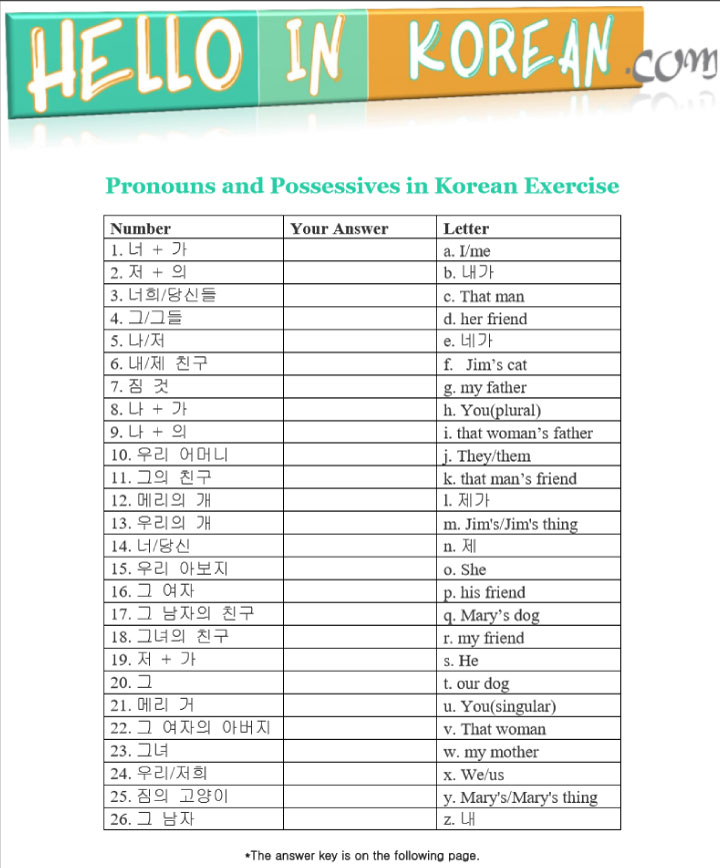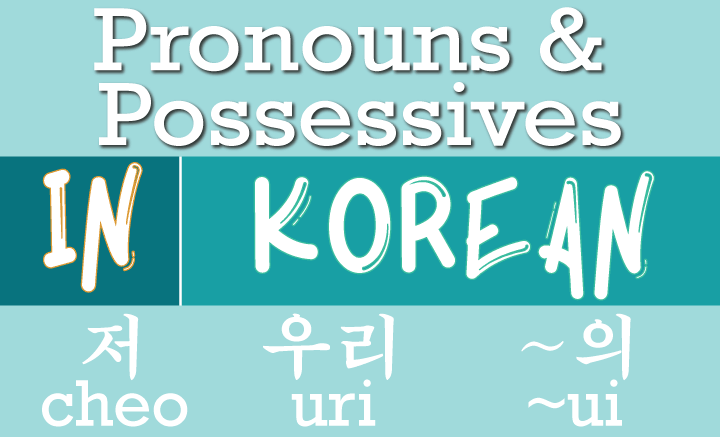Pronouns and Possessives in Korean
Pronouns and Possessives in Korean are very important tools. Pronouns include words like I, me, she, you, and more. Possessives include words like my, your, Jim’s, and more. Pronouns and possessives are often dropped when speaking if they are understood with context. This takes some time for you to get used to. You should not drop them as you practice so you can get a good handle on them. In time you’ll be a pro.
Pronouns in Korean
In English pronouns change based on if the pronoun is the subject or the object in a sentence.
Ex.
I like the dog.
The dog likes me.
Both I and me refer to the same person in these sentences. Korean uses the subject particles 이/가 and object particles 을/를 to do this. So in Korean pronouns do not change based on if the pronoun is the subject or the object.
1. I/me in Korean
| Informal | Formal | English |
| 나 | 저 | I, me |
When the subject particle ~가 is attached to 나 or 저 they change.
나 + 가 = 내가
저 + 가 = 제가
2. We/us in Korean
| Informal | Formal | English |
| 우리 | 저희 | We, us |
It’s okay to use 우리 in formal situations.
3. You in Korean (singular)
| Informal | Formal | English |
| 너 | 당신 | You(singular) |
When the subject particle ~가 is attached to 너 it changes.
너 + 가 = 네가
니 or 니가 can be used to say “You” in Korean. 니 or 니가 are informal and can be used with very close friends but they can have a negative connotation. This is a dialect but many people use 니가 because 내가(I/me) and 네가(you) sound the same and are easy to confuse.
The formal 당신 is not usually used, even to older people. A job title or a family relationship word like, “Father” 아버지, is more appropriate. In a restaurant you could say “Excuse me” 여기요.
당신 can often be heard in music and in dramas.
4. You in Korean (plural)
| Informal | Formal | English |
| 너희 | 당신들 | You(plural) |
니들 is informal and can be used with very close friends but it can have a negative connotation. 당신들 is not very common. A word like “Everybody” 여러분 or 여러분들 is more common and used when addressing a group of people that deserve respect.
5. Demonstrative Pronouns
그 is “That” in Korean and can be placed before a noun.
| Demonstrative | English |
| 그 남자 | That man |
| 그 여자 | That woman |
6. He, She in Korean
| Demonstrative | English |
| 그 | He |
| 그녀 | She |
“He” and “She” in Korean are demonstrative pronouns.
7. They/them in Korean
| Demonstrative | English |
| 그 | They, them |
| 그들 | They, them |
“They” and “Them” in Korean are also demonstrative pronouns.
Learn Korean Language Tips
Koreans often don’t use pronouns in conversation when the people speaking know what is being talked about.
Ex.
A: Did you eat?
B: Ate.
Conversations like these happen all the time so be aware of this when you don’t hear people using pronouns.
[mailmunch-form id=”318851″]
Korean Possessives and the Particle ~의
Possessives identify who owns or possesses an object. This is done in English with my, mine, his, name’s(Rob’s), etc.
There are three ways to do this in Korean.
1. Possessor의 noun
The possessor has the particle ~의 attached to it followed by what is possessed.
Ex.
짐의 고양이 = Jim’s cat
메리의 개 = Mary’s dog
If 의 is attached to 나 or 저 they change.
나 + 의 = 내
저 + 의 = 제
내 친구 = my friend
제 친구 = my friend
그의 친구 = his friend
그녀의 친구 = her friend
그 남자의 친구 = that man’s friend
그 여자의 아버지 = that woman’s father
우리의 개 = our dog
누구 = who
누구의 = whose
Korean Language Learning Tips
우리 sometimes means “My” in Korean.
내 아버지 = my father
제 어머니 = my mother
While these translations are correct, this is not how Koreans speak. Koreans have a more communal view in terms of language and say “Our father” or “Our mother” when they mean “My father” or “My mother.”
우리 아버지 = my father
우리 어머니 = my mother
2. Possessor noun
The Korean possessive particle 의 is often dropped.
Koreans love to make sentences short as long as everything can be understood.
Ex.
짐의 고양이 = Jim’s cat
짐 고양이 = Jim’s cat
3. Possessor 것
The word thing can be placed after the possessor to show ownership.
것 = thing
거 = thing
Ex.
짐 것 = Jim’s/Jim’s thing
메리 거 = Mary’s/Mary’s thing
Pronouns and Possessives in Korean Exercise

Fill out the form below to get the answer key
[mailmunch-form id=”318851″]


Leave a Reply
You must be logged in to post a comment.